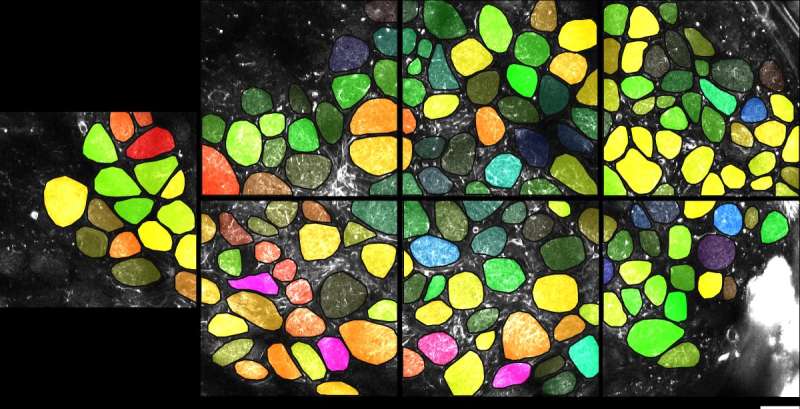What's that smell? The advantage of sniffing

Researchers led by Takeshi Imai at the RIKEN Center for Developmental Biology (CDB) have discovered how the physical and sensory perceptions associated with sniffing are kept separate and why sniffing can help identify odors, two problems that have puzzled scientists for years. Published in Neuron on December 6th, the study used a system in mice that systematically controls airflow and odor delivery to show that odors are coded by precise differences in the timing—or phase—of brain activity during each sniff, a phenomenon known as phase coding.
Imagine the smell as you drive by a chocolate factory. Each compound in the aroma activates specific neurons in your nose, which converge in the olfactory bulb of the brain on structures called glomeruli. In this way, chocolate will activate "chocolate" glomeruli. The neurons in your nose also respond when they are pushed by the air, but in this case, the activation is not as specific. So sniffing will activate "chocolate" and "non-chocolate" glomeruli. From the brain's point of view, how can it tell whether the signals it receives from the glomeruli contain air-flow information or odor information?
The answer, Imai explains, is all about timing. "Surprisingly, we found that temporal firing patterns of neurons can distinguish between airflow-driven mechanical signals and those generated by odors. Not only that, we discovered that the mechanosensation actually improves olfaction by acting as a pacemaker for temporal patterning."
To arrive at this discovery, the team devised a system to artificially control rhythmic sniffing in mice. They first presented deodorized air to the mice and recorded activity from neurons in the glomeruli of the brain. They found that a large number of glomeruli were activated by airflow, and that the activity went up and down in cycles that matched the rate of the artificial sniffing. However, although the rate was the same, the glomeruli were out of phase with each other. For example, while one glomerulus might be most active 200 milliseconds into each sniff, another might be most active at 230 milliseconds, and another at 400 milliseconds. This phase code is best understood by looking at the phase maps of glomeruli activity created using calcium imaging.
The team next looked at how increasing airflow and odor stimulation affected the phase of activity in the glomeruli. They found that increasing the airflow speed increased the amount of glomeruli activity, but did not change their phases very much. In contrast, when they presented odors to the mice, they found that the timing of glomeruli activity shifted significantly within the sniff cycle. Further testing showed that the phases shifted the same amount no matter what the odor concentration. This discovery shows that odor and airflow stimulation can be distinguished by looking at the phase of activity in the glomeruli, and that the phase indicates the odor identity irrespective of the concentration.
But why are neurons in the nose sensitive to air pressure at all? To answer this question, the team examined responses to odors when airflow was artificially constant, without any rhythm. They found that continuous airflow reduced the precision of the phase code, especially at low odor concentrations, which would make it more difficult to distinguish one odor from another.
"Phase-coding is not unique to the olfactory system," notes Imai. "Although it has also been found in the hippocampus in relation to memory formation, we still do not know much about it. Hopefully, our finding will facilitate a better understanding of how neurons communicate with each other and how meaning can be derived from their signals."
"Our next step is to understand how the precise temporal patterns are generated in the olfactory bulb, and why they are affected by odors but not mechanically originating signals."
More information: Iwata R, Kiyonari H, Imai T (2007) Mechanosensory-Based Phase Coding of Odor Identity in the Olfactory Bulb. Neuron. DOI: 10.1016/j.neuron.2017.11.008


















